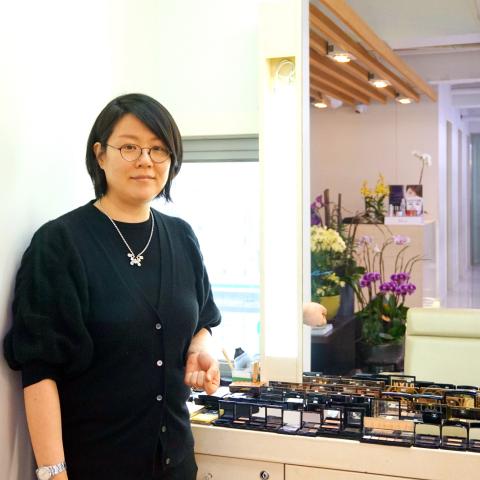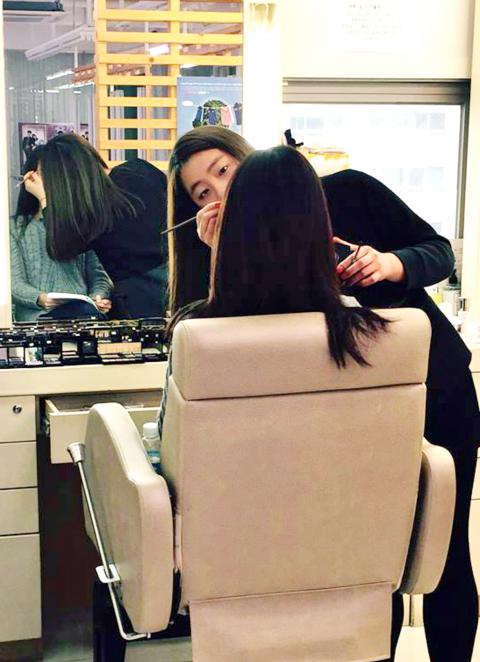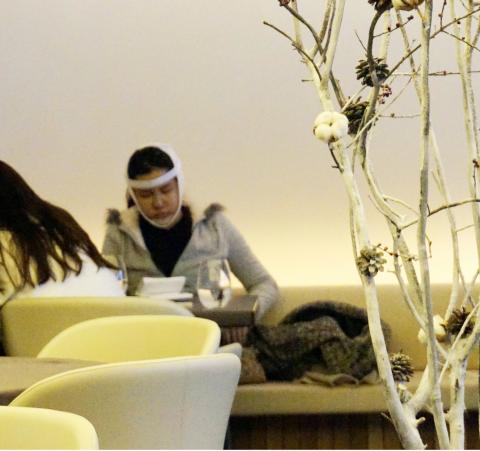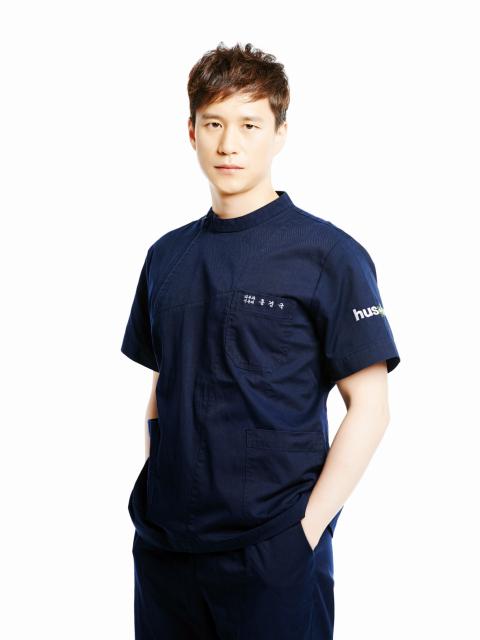“Botox.”
That was one word the consulting manager at a high-end plastic surgery clinic in Seoul’s Gangnam district said to me that I didn’t need my army of Chinese translators to interpret.
The manager, who had a tiny mousey face, diminutive jaw and big bug eyes, did not bat an eyelash during the approximately five seconds she spent examining my face before recommending that I inject a toxin into my cheeks.

Photo: Dana Ter, Taipei Times
“It’ll make your cheeks rounder and your face slimmer,” says one of the translators. Her explanation is bereft of any medical terminology.
In the chair next to me, my mother is holding back laughter — but the stern stares of the manager and the five Chinese translators in black pencil skirts and blazers hawking over us are only making it worse.
Botox was nothing compared to what was suggested to my mother — two sessions of blemish removals, 10 sessions of laser toning, Ulthera to lift the face and fillers for laugh lines. All of this came at a discounted price of US$4,500.

Photo: Dana Ter, Taipei Times
Thanking the manager and her entourage of uniformed translators, we said we’ll think about it. But they are noticeably annoyed as we leave, knowing that we are going to reject their hard-sell sales pitch.
We navigate through a maze-like waiting room with sparkling white marble floors filled with hundreds of men and women flipping through brochures of before and after pictures and their children running around. Then we swiftly make our escape into the frigid wintery air of the outdoor parking lot, driving off without glancing back.
SPOT THE BANDAGES

Photo: Dana Ter, Taipei Times
It’s common to see women in head bandages sitting in coffee shops and restaurants in Gangnam, Seoul’s ultra-hip area made famous by pop singer Psy. So much so that we play a game of spot-a-woman-in-head-bandages whenever we’re out for a family lunch in Apgujeong or Cheongdam — sub-districts in Gangnam lined with designer clothing stores.
As Dr Hong Kyung-kook of Hushu Dermatology Clinic in Apgujeong tells me, “people who get plastic surgery are not ashamed of it since it is very common, especially in Gangnam.”
He adds, however, that “women with head bandages could be medical tourists since usually, Korean women stay at home after plastic surgery until they are fully recovered.”

Photo courtesy of Hushu
The topic of plastic surgery and medical tourism in South Korea has been spliced, dissected and examined from all angles. Reuters published an article last year on “Trouble brewing in South Korea’s plastic surgery paradise.” There was also a recent AFP article entitled “Chinese cosmetic tourists reap regret in South Korea.” Both stories talk about South Korean and Chinese patients regretting their decisions to go under the knife, as well as the rise in the number of quacks and the malpractice suits that result from their questionable procedures.
While all of this is horrifying, there is more to Gangnam than just plastic surgery and Botox fillers. Hong, for instance, regularly sees patients as young as 14 for treatments to prevent acne scars. Gone are the days of popping pimples in your high school bathroom. Instead, Hong recommends high tech remedies.
“There are several options,” he says. “Oral or topical medication, anti-inflammatory injections, mild photodynamic therapy (PDT) and Vbeam PDT.”
At least his explanation sounds more scientific than the bug-eyed manager at the other Gangnam clinic.
AU NATUREL
Whether it is jaw contouring or zapping zits, there is something for everyone in this beauty capital of South Korea. It’s best to view this famous district as a one-hop stop for grooming and makeovers. What started as dreaded consultations at skin clinics and dental spas during trips to see my family turned into voluntary appointments as I slowly learned how to sieve through the good, the bad and the surreal.
During my three-day stopovers, I’ll grab some snail masks, CC cream, intensive care conditioner and soft bristle toothbrushes and I’m good to go — no Botox, thanks.
Indeed, for every bizarre story, there is a pleasant one.
“You have big eyes. We should bring out that quality,” says Jung Eun-joo, the manager of Kim Chung-kyung Hair-Face. Her store is located in a tall, narrow building in Cheongdam. We are sitting in the sixth floor consultation room — a cozy place with potted plants and beige swivel chairs overlooking the grey streets — as she examines my bone structure to see what features to accentuate.
The fifth floor of Kim Chung-kyung is for skin consultations, the seventh floor is devoted to hair styling, while the eighth floor provides manicures and pedicures. In the sixth floor waiting area, brides-to-be are trickling in and perusing books on makeup tips. A good portion of Jung’s clientele are also women who drop by before going on blind dates and job interviews. The average cost for a basic makeup session is around US$225.
Having consulted with numerous customers, Jung has noticed a growing trend.
“The beauty focus today is on looking youthful and luminous,” she says. “In the 1990s, you’d see women with heavy makeup on television, but nowadays, women prefer a more natural look with lighter makeup.”
Jung attributes the change not solely to popular culture and celebrities, but to makeup artists themselves who started investing in the idea of a holistic relationship between skincare and makeup.
Achieving the au naturel look takes approximately 30 minutes of tweaking, priming and powdering during which my makeup artist Lee Nam-hee applied moisturizing cream, two colors of base foundation, a couple dabs of powder, lip shine, eyeliner and some eyebrow plucking. My instructions were clear: no fake eyelashes. The process was relaxing and it did not feel like I had an ounce of makeup on for the rest of the day.
Before I left, however, Jung had one request. “Can you Photoshop me a little?” she says, implying that she wished to appear slimmer should I choose to use her photo.
SPLITTING HAIRS
A 10-minute drive from Kim Chung-kyung Hair-Face and I’m in the Apgujeong branch of Leekaja Hair Bis (LKJ). Despite sightings of members from the K-pop groups Big Bang and 2NE1 in this hair salon, Pete Kang, the creative director, couldn’t have been less aware of the fashion trends or hairstyles that his star-studded clientele might be jettisoning.
“I don’t follow fashion fads. I’ll examine the person’s face shape, skin tone and hair type and give them a 10-minute consultation, three-to-four minutes for regular customers,” Kang says.
Like other grooming gurus in Gangnam, Kang has flawless, porcelain skin and soft, shiny hair. “The secret is simple: foods that are good for your skin are also good for your hair,” he says.
“Hair is something that we cannot change for a while,” Kang adds. “We’re not trying to sell a fashion line, like ‘here is our spring 2015 look’ or something.”
A basic haircut without coloring or treatment is an affordable US$100 which is why LKJ is popular amongst young people. Kang’s regular customers come from places like Japan and Hong Kong. They’ll visit Seoul every few months, buy a few purses and dresses in Gangnam and stop by LKJ for a haircut.
“We provide quality and affordability — haircuts don’t need to be in fancy places, just a salon that people can trust to deliver the right results,” Kang says.
I left the salon cured of split ends, my hair feeling soft and bouncy with lots of layers. After hours of priming and pruning, I am finally ready to enjoy a green tea latte in a coffee shop in Apgujeong with my natural makeup and natural, flowing hair.
Except for the slight risk of becoming permanently disfigured if you opt to go under the knife, this beauty stuff is not innately good or bad. Gangnam is more than just a plastic-surgery-mecca-turned-mockery-game. Rather, it’s what you choose to make out of it.

The canonical shot of an East Asian city is a night skyline studded with towering apartment and office buildings, bright with neon and plastic signage, a landscape of energy and modernity. Another classic image is the same city seen from above, in which identical apartment towers march across the city, spilling out over nearby geography, like stylized soldiers colonizing new territory in a board game. Densely populated dynamic conurbations of money, technological innovation and convenience, it is hard to see the cities of East Asia as what they truly are: necropolises. Why is this? The East Asian development model, with

June 16 to June 22 The following flyer appeared on the streets of Hsinchu on June 12, 1895: “Taipei has already fallen to the Japanese barbarians, who have brought great misery to our land and people. We heard that the Japanese occupiers will tax our gardens, our houses, our bodies, and even our chickens, dogs, cows and pigs. They wear their hair wild, carve their teeth, tattoo their foreheads, wear strange clothes and speak a strange language. How can we be ruled by such people?” Posted by civilian militia leader Wu Tang-hsing (吳湯興), it was a call to arms to retake

This is a deeply unsettling period in Taiwan. Uncertainties are everywhere while everyone waits for a small army of other shoes to drop on nearly every front. During challenging times, interesting political changes can happen, yet all three major political parties are beset with scandals, strife and self-inflicted wounds. As the ruling party, the Democratic Progressive Party (DPP) is held accountable for not only the challenges to the party, but also the nation. Taiwan is geopolitically and economically under threat. Domestically, the administration is under siege by the opposition-controlled legislature and growing discontent with what opponents characterize as arrogant, autocratic

Desperate dads meet in car parks to exchange packets; exhausted parents slip it into their kids’ drinks; families wait months for prescriptions buy it “off label.” But is it worth the risk? “The first time I gave him a gummy, I thought, ‘Oh my God, have I killed him?’ He just passed out in front of the TV. That never happens.” Jen remembers giving her son, David, six, melatonin to help him sleep. She got them from a friend, a pediatrician who gave them to her own child. “It was sort of hilarious. She had half a tub of gummies,